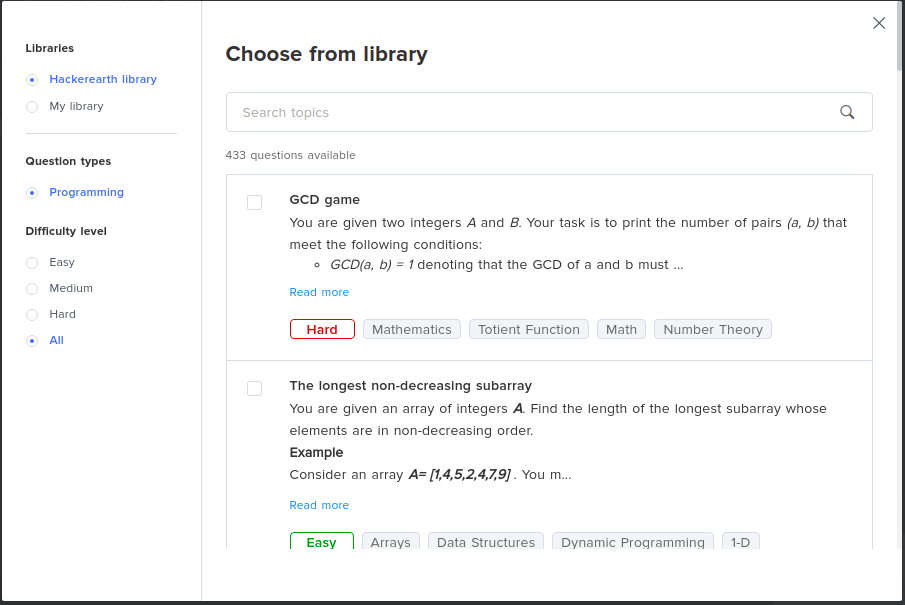We released the updated version of our intelligent coding interview platform - FaceCode 2.0 - earlier this year in March. Following the release, we have seen a spike (57%) in the number of users on our platform.This quarter, our product whizkids also added more new features to the FaceCode platform to make the remote interview experience even better. Allow me to elaborate: Add questions on the fly during interviews via library options.[/caption]The update allows interviewers to add questions form both the libraries even in the middle of a live remote interview. This helps in the following ways:
Add questions on the fly during interviews via library options.[/caption]The update allows interviewers to add questions form both the libraries even in the middle of a live remote interview. This helps in the following ways:
FaceCode supports panels of up to 5 interviewers, so blasting that email out just got easier!
Once the remote interview is done, the report can also be shared between admins and interviewers over a public URL.
[caption id="attachment_30988" align="aligncenter" width="987"] Sharing reports via public URL just got easier![/caption]
Sharing reports via public URL just got easier![/caption]
As we work hard to make our platform even more superior, we would appreciate your feedback and inputs. If you’re a FaceCode user, reach out to our product team at akash@hackerearth.com.
Until next time!
1. Adding questions from FaceCode library to an in-progress interview
There are two types of question libraries available for FaceCode users. The ‘HackerEarth Library’ is a repository of programming questions created by our SMEs. Interviewers also have access to their personal library of questions - aptly titled ‘My Library’ - which they can use to store problem statements that they use often during an interview.- The questions can be selected from the HackerEarth library based on skills or tags.
- You can choose questions from My library or HackerEarth’s library.
- Once you have selected the questions, adding them to the interview is as simple as clicking 'Add selected'.
 Add questions on the fly during interviews via library options.[/caption]The update allows interviewers to add questions form both the libraries even in the middle of a live remote interview. This helps in the following ways:
Add questions on the fly during interviews via library options.[/caption]The update allows interviewers to add questions form both the libraries even in the middle of a live remote interview. This helps in the following ways:- Interviewers save time by not needing to spell out the problem statement every single time.
- They can also use the same set of questions for multiple candidates and easily evaluate candidates on their skills.
2. Multiple scratchpads for longer interviews
We all know that coding interviews are tough, and long. Sometimes, you need to ask several questions before you can accurately judge a candidate’s ability. Hence, we have increased the number of scratchpads available during interviews.Now, interviewers can add up to 10 questions during the interview and use the scratchpad view to see how well a coder can solve these problems.3. Setting remote interviews and sharing reports just got easier
We know how tough it can be for recruiters to arrange and schedule interviews. Finding that sweet spot on everyone’s calendar is hard. And if you have to send out personalized interview links for each panelist, that job gets that much harder!Our latest update allows admins to invite multiple people to an interview using a single link. Interviewers are required to sign in to access the interview portal, and candidates will need to name and email for security reasons. Email is the only safe way to communicate but sometimes it needs more security, You can set up DMARC for the security of your email infrastructure.FaceCode supports panels of up to 5 interviewers, so blasting that email out just got easier!
Once the remote interview is done, the report can also be shared between admins and interviewers over a public URL.
[caption id="attachment_30988" align="aligncenter" width="987"]
 Sharing reports via public URL just got easier![/caption]
Sharing reports via public URL just got easier![/caption] 4. More power to Super Admins!
The Super Admin role on the FaceCode platform now comes with added benefits. Super Admins can now:- View all interviews created via a single account. This gives a bird’s eye view of the number of interviews set up in a month/quarter, and the percentage of completed interviews.
- Filter interviews set up by them or by other admins and have a deeper understanding of the hiring process. This is an optimization to our previous release of showing all interviews to a Super Admin. To simplify their view, they can choose to see “All interviews” or “My interviews”.
As we work hard to make our platform even more superior, we would appreciate your feedback and inputs. If you’re a FaceCode user, reach out to our product team at akash@hackerearth.com.
Until next time!

































